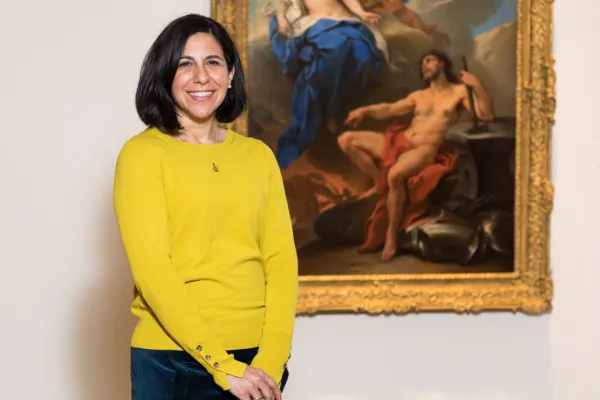Making Art Accessible: SCMA Curator Danielle Carrabino
Smith Arts

Published November 13, 2018
There is no artwork yet posted on the walls of Danielle Carrabino’s office in the Smith College Museum of Art.
That’s because Carrabino, the museum’s new curator of painting and sculpture, has been too busy getting to know works in the SCMA’s collection to decorate her office.
Smith’s collection, she says, “just keeps getting better the more I know about it. I’ve been spending a lot of time in storage just pulling things out to look at.”
An Italian Renaissance and Baroque art scholar and educator who previously served as a member of the curatorial team at the Harvard Art Museums, Carrabino began work at Smith in June overseeing installation and interpretation of painting and sculpture at SCMA.
A Florida native who spent much of her childhood in Florence, Italy, Carrabino says she has long been attracted to college art museums because of their mission to explore and teach.
Here’s what else Carrabino had to say about her work at Smith.
What drew you to Smith?
“I really love university and college art museums; that’s my niche—the place I feel most comfortable. SCMA’s collection was one of the first for a college museum, so it’s always been in my mind. When I visited again recently, I was convinced that this position would be a great fit.”
What’s are your thoughts about painting and sculpture at SCMA?
“What sets our collection apart is, first and foremost, its quality. The caliber of artists we have—Degas, Courbet, the 17th-century Dutch masters—there’s just so much here. The scope of the collection I oversee—from ancient art to the 1950s—is encyclopedic for a museum of our size; it covers a lot of time and geography. My specialty is 16th- and 17th-century Italian art, and I would love to grow that part of the collection.”
What is the status of painting and sculpture in our present era?
“I have friends and colleagues who say that painting and sculpture are passé. But in order to really understand modern and contemporary art, it is often helpful to know what came before. Painting and sculpture from the past is still relevant because it’s about humanity.”
As a curator, how do you address the ways that gender, race and class are reflected in art?
“Historical works of Western art tend to be by white men. Instead of rewriting history, there are ways to identify imbalances and oversights by deepening our engagement with works in the collection.
A related issue—and a big part of my mission—deals with the problem that the majority of people in America don’t feel like they can go to a museum and feel welcome or even know what they want to look at. We’re working on that. There’s a movement in museums towards inclusivity, and we’re part of that conversation. Our whole purpose is to make art accessible.”
What are you looking forward to most about your first year at Smith?
“I’m teaching an Italian class in November for students who are preparing to study abroad in Florence, and another for students learning to paint. I’m still getting to know faculty members here, and I’m looking forward to opportunities to collaborate with them. I love that you can see the collection through different lenses and put things together in different ways. I’m also glad to be working with all of the other curators here on planning an exhibition for the SCMA’s Centennial in 2020 that will cover, not only what’s in the collection, but also how it grew—its history from the moment that Smith went from collecting art for teaching to becoming a museum.”